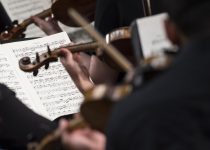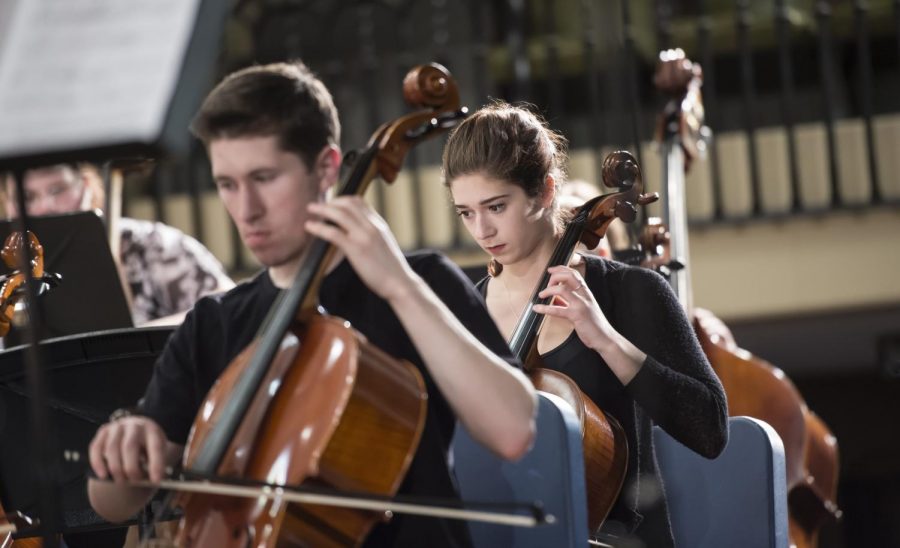Pitt Symphony Orchestra returns to in-person concerts for the holidays
Image courtesy of Philip Thompson
Pitt cellists play at a symphony orchestra concert at Bellefield Hall Auditorium in August 2018.
November 18, 2021
The Pitt Symphony Orchestra has been performing digitally ever since the COVID-19 pandemic started, but this semester they’re finally returning to in-person performances and practices.
The orchestra is made up of 50 students, most of whom aren’t music majors, and is directed by Roger Zahab. The group’s first in-person concert was scheduled to occur Wednesday evening, but was cancelled due to flooding in Bellefield Hall. Their next performance will take place Dec. 8.
Zahab has been orchestra director since 1993. Eric Moe — the co-director for Music on The Edge, another Pitt ensemble group — hired him, at first thinking it would be a temporary position.
Zahab said he would be happy to direct the orchestra. Zahab’s performance impressed Don Franklin, the then-music department chair, who asked him to stay.
“The chair at the time welcomed me, and said you’re just here for one year because then we’re going to get rid of it,” Zahab, the current music department chair, said. “At the end of that first year, Don Franklin came to me and said, ‘Unfortunately you’ve done too good a job, we can’t get rid of you now.’”
Cullyn Murphy, the orchestra’s assistant conductor, took a sort of a backward approach to the orchestra. He never played in an orchestra and got the majority of his musical experience through theater. He said Zahab helped him immensely in his new position.
“Before this semester, I had really taken a three-year conducting hiatus, coming back from that was really daunting,” Murphy said. “I am really grateful for Roger’s encouragement and instruction and feedback to welcome me back to this space.”
Miranda Sousa, a music graduate student, has been playing in orchestras for about 10 years. She plays the double bass and was the assistant conductor before Murphy.
“I have been playing in orchestras for 10 years, so it was just natural to continue it here in the Symphony Orchestra. Right now I play the double-bass in the orchestra, but I was the assistant conductor for two years, I was Roger’s assistant for two years, that’s what Cullyn is doing now.”

COVID-19 affected the orchestra profoundly, according to Zahab. He said orchestras have a lot of social components, which were hard to replicate at the height of the pandemic.
“The social side is not less important than the artistic side,” Zahab said. “It is a chance for our players to drop their work schedule and to just take out their instrument and play music and to see their friends, and that went away.”
Murphy welcomed the return to in-person practice with open arms, and said he’s already excited seeing how the musicians are interacting with one another.
“Two people in the orchestra could never talk to each other, but as the semester progresses, I can see how they are learning about each other through the way they’re playing,” Murphy said.
COVID-19 also impacted musical ability in the orchestra. In order to hold concerts during the pandemic, each instrument recorded its part individually, and then Zahab spliced them together in order to make the music work.
Zahab said this was very stressful, as he went through the entire pandemic working on each individual person’s recorded works — but he also found it as a way to learn something new.
“I worked for what felt like 70-hour work weeks, it was really a nightmare, but it was fascinating to learn,” Zahab said.
Sousa said she thinks that the pandemic highlighted the importance of being a community. Since they were separated so long physically, it made it more important when they got back together emotionally.
“It showed that we’re lucky to have the opportunity to make music with other people when we’re together,” Sousa said.
Now that the symphony is back in person, the group rehearses on Wednesdays in Bellefield Hall. The group has five rehearsals in between concerts.
“It’s always ready a day before it needs to be ready, instead of the day of. Our last rehearsal could’ve been our concert, and it would’ve been amazing,” Murphy said.
And that isn’t solely on the audience either. The orchestra’s music also affects its own musicians, according to Zahab.
“At the beginning of rehearsal, there is a lack of focus that they haven’t entered into this new space, but within half an hour,” Zahab said. “The consummation is phenomenal, and when people leave, they’re exhausted, but they seem so relaxed, so happy.”
The orchestra itself has a varied selection of music choices. It plays everything from Nepomuceno, Brahms and Beethoven — along with more modern classical pieces.
Zahab said he thinks almost anyone can be a musician. He said even the audience is a musician in a way.
“If one plays music and loves it, one is a musician, one could be a musician if one simply listens carefully with devotion and interest,” Zahab said.
Murphy said he was eager for the orchestra to be seen playing different pieces at its upcoming concert, and showing their collaborative spirit.
“This program is a wonderfully thought out piece of music. It will have a lot of variety and demonstrate the orchestra is both a community of individuals and a grouped up community,” Murphy said. “Collaboratively breathe life and rip it to shreds over and over and come out with a completely new being.”








